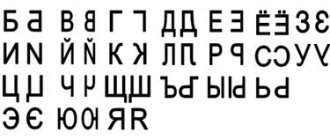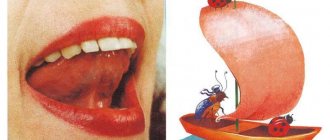Dysarthria is a name for speech disorders caused by damage to the central nervous system. The disorder is characterized by a decrease in the mobility of the speech apparatus, as a result articulation suffers. Dysarthria in children can cause incorrect pronunciation of words, writing and reading disorders, as well as general underdevelopment of speech, or its complete absence.
Among various speech therapy pathologies, dysarthria ranks second in prevalence, only dyslalia is more common. Therefore, today much attention of specialists and parents is paid to this speech disorder.
Characteristics of bulbar dysarthria
Bulbar dysarthria is a pathology that appears when speech function is impaired due to damage to the nerves located in the muscle tissues of the pharynx and larynx. As a result of disruption of the connection between the muscles of the speech organs and the central nervous system, the functioning of:
- larynx;
- pharynx;
- palate;
- language;
- lips
The characteristics of the disease are as follows: bulbar dysarthria is manifested by the loss of the ability to pronounce voiced sounds, the sound acquires a neutral tone, and labial sounds are distorted. The patient's voice strength decreases, speech becomes unclear and incomprehensible.
When the soft palate sag, a nasal pronunciation is noted, since when exhaling, the air flow moves freely through the nose. And with atrophy of the pharyngeal muscles, problems with swallowing food arise.
Both adults and children of any age category can encounter pathology. But in childhood the disease is more unfavorable. A sick child cannot write at a sufficient speed, reads poorly, and has impaired diction.
Extrapyramidal dysarthria
Extrapyramidal dysarthria (or subcortical) is a form of speech disorder that occurs as a result of damage to the subcortical nodes and their nerve connections. This pathology is characterized by involuntary movements of the facial and respiratory muscles, as well as involuntary movements of the tongue. Such movements may not appear for some time and intensify when the child tries to make a voluntary movement. At the same time, the pronunciation of individual sounds can be preserved.
Overall speech intelligibility depends on control of speech breathing and voice, and is affected by vocal strength. If the voice sounds good, speech can be quite understandable. The sonority of the voice is inconsistent. As a rule, extrapyramidal dysarthria is characterized by attenuation of the voice towards the end of the phrase. The child's voice may be dull and strained. There is no fluency of speech.
Subcortical dysarthria is characterized by incoordination of the movements of the respiratory and articulatory muscles. The tone of the muscles of the neck and shoulder girdle is often increased. There is no stability in the construction of the phrase. With sharp spasms, speech is impossible. In addition, this form of dysarthria can be combined with hearing impairment such as sensorineural hearing loss.
Symptoms of bulbar dysarthria
Speech and non-speech symptoms are noted. The symptoms are numerous, and the effectiveness of subsequent treatment depends on their timely detection.
Speech signs of the development of bulbar dysarthria:
- slurred speech (even parents cannot understand what the child is talking about);
- impaired articulation of the tongue and lips;
- low mobility of the vocal cords (as a result of which the child is unable to speak loudly);
- deafness and nasality of pronunciation (voiced sounds are not heard by ear).
Non-speech symptoms of bulbar dysarthria:
- shallow and uneven breathing;
- weak facial expressions;
- excessive salivation;
- complete or partial paralysis of the muscles of the trunk or limbs;
- distorted perception of the surrounding space;
- inability to focus the gaze on a selected object due to damage to the extraocular muscles;
- emotional and mental disorders.
The pathology is dangerous because it can develop in infancy. But identifying it in a baby is problematic. The mother needs to immediately contact a pediatrician if, while breastfeeding, the baby chokes and spits up all the time. From 3 months of age, babies begin to babble, and it becomes easier to identify the disease. If the babbling sounds distorted, then you need to take the child to the doctor.
What to do? Treatment methods for the disorder
The child must undergo additional classes with a speech therapist (at home or in a special institution) on:
- development of motor skills;
- forming a conversation;
- honing diction;
- correcting the pronunciation of distorted sounds;
- expanding vocabulary;
- development of phonetic hearing;
- memorizing grammatical structure.
Against this background, drug therapy is carried out using nootropics. Medicines in this group specifically affect brain functions: stimulate mental activity, cognitive functions, increase learning abilities, and improve memory.
The package of measures also includes exercise therapy - articulation gymnastics to strengthen the facial muscles, massage, exercises with the hands and fingers.
Sources:
- E.F. Arkhipova. Erased dysarthria in children: a textbook for university students // M.: AST: Astrel: KHRANITEL, 2006, p. 319.
- L.I. Belyakova, Yu.O. Filatova. Diagnosis of speech disorders // Defectology, 2007.
- 3. O.Yu. Fedosova. Features of sound pronunciation of children with mild dysarthria // Speech therapist in kindergarten, 2005, No. 2, pp. 36-41.
The information in this article is provided for reference purposes and does not replace advice from a qualified professional. Don't self-medicate! At the first signs of illness, you should consult a doctor.
Causes
The connection between motor neurons and the central nervous system can be disrupted as a result of even minor exposure to negative factors. Motor nerves are most vulnerable during fetal development. For the fetus to develop a pathology, the mother only needs to get sick or have bad habits.
The main causes of bulbar dysarthria:
- Traumatic brain injuries, both open and closed. This also includes brain damage sustained by a child during a difficult birth process.
- Impaired cerebral circulation. Due to a lack of blood supply to tissues, ischemic damage to neurons occurs. Nerve cells cease to function fully. The pathological process can develop as a result of stroke, hypertension, atherosclerosis, diabetic damage to the circulatory system.
- Infectious lesion of the nervous system. Under the influence of infection, the nerve fibers become inflamed and compressed by swollen muscle tissue. This phenomenon is observed with encephalitis, poliomyelitis, neurosyphilis, damage by echinococcus, and the formation of ulcers.
- Brain tumors. Neoplasms, growing in brain tissue, capture nerve fibers. As a result, the functioning of the central nervous system is disrupted.
- Degenerative diseases of the brain. They lead to atrophic changes in nerve tissue and affect the bulbar nerves (glossopharyngeal, vagus, hypoglossal). Such pathologies are usually hereditary.
- Abnormal structure of the cranial base. A rare cause of speech disorders caused by compression of the medulla oblongata by a deformed skull. Bulbar dysarthria is observed with basilar invagination (pressing of the occipital bone into the skull), assimilation of the atlas (fusion of the cervical vertebra and occipital bone), Chiari malformation (descent of the cerebellar tonsils into the foramen magnum).
Bulbar dysarthria is not an independent pathology, but only a sign of diseases accompanied by damage to the bulbar nerves that provide speech ability. Most often it is diagnosed in children and the elderly. In most cases, speech impairment is the first characteristic sign of the development of a serious disease in the body that requires urgent treatment. Therefore, if speech defects occur, you should immediately go to a neurologist.
Reasons for development
Dysarthria is not an independent disease, although often this speech disorder is the main manifestation of various pathologies of the central nervous system. In most cases (up to 85%), dysarthria accompanies cerebral palsy. Malformations of the nervous system can be caused by a variety of reasons:
- pathological conditions of the fetus during intrauterine development. These include severe toxicosis and the pathological course of pregnancy, chronic maternal diseases and intrauterine infections, hypoxia, asphyxia or ischemia of the fetal brain, Rh conflict, etc.;
- genetic predisposition (presence of severe hereditary pathologies);
- head injuries and illnesses suffered by a child in the first few years of life. These include hydrocephalus, meningitis and other neuroinfections, purulent otitis media, as well as poisoning with toxic substances and intoxication due to infectious diseases.
The above reasons lead to damage to the parts of the brain that control movement, the cerebellum, basal ganglia, brain stem, nerve fibers and their connections with muscles.
Manifestations of dysarthria are different, and they depend on which part of the central nervous system is affected.
Differences between bulbar and pseudobulbar dysarthria
When characterizing bulbar dysarthria, the pseudobulbar form is distinguished. The two forms of the disease have similar symptoms. The difference is that bulbar involves damage to peripheral nerve cells, pseudobulbar - central.
Pseudobulbar dysarthria manifests itself:
- decreased physical activity;
- significant memory loss;
- deterioration of concentration;
- impaired functioning of the articulatory apparatus, but without muscle paralysis (this symptom is the main difference from the bulbar form);
- distortion of the pronunciation of sounds;
- periodic involuntary contraction of the facial muscles in the mouth and chin.
Treatment and correction methods
Before starting treatment, the patient is sent for diagnostic tests to determine the severity and stage of development of the disease that caused the speech disorder.
For bulbar dysarthria, complex therapy is used, including:
- Taking medications that stimulate brain function and restore mental capacity.
- Taking medications that reduce salivation. It is impossible to do without these drugs, since the saliva in patients flows very strongly; an amount exceeding a liter can flow out per day.
- Surgical intervention to eliminate the pathology that provoked a speech disorder: an abscess, a tumor, a collection of blood after a stroke.
- Restoring the body's functionality. To do this, take vitamin complexes.
- Elimination of respiratory dysfunction. Artificial ventilation of the lungs is carried out.
- Speech therapy classes help restore the functionality of the articulatory organs, normalize the pronunciation of sounds, and make speech clear and expressive. Massage procedures and articulation gymnastics are carried out.
- Physiotherapeutic measures, therapeutic baths, acupuncture.
An important corrective stage of complex therapy is attending sessions with a speech therapist. The specialist prescribes exercises to help develop the organs of articulation. Through classes:
- clear and intelligible speech is restored;
- voice and speech breathing are put on;
- articulatory muscles are strengthened;
- Pronunciation errors are corrected.
To increase the mobility of facial and tongue muscles, speech therapy massage for children at home, as well as speech therapy massage with probes, is used.
Below are examples of simple and effective exercises for bulbar dysarthria:
- The child throws back his head, makes movements with his mouth, as if he is chewing and swallowing something. The mouth must be closed.
- The patient opens his mouth wide, presses his tongue against the upper teeth, and holds it in this position for 10–15 seconds.
- The speech therapist places small objects on the child’s lips, and the child tries to hold them for as long as possible.
- The patient inflates and retracts his cheeks with his mouth closed.
The described exercises are effective in their simplicity. They can be done at home if it is impossible to regularly visit a speech therapist. It is advisable to work with your child 2–3 times a day. Only in this case will it be possible to quickly achieve normalization of pronunciation.
Treatment of dysarthria
Since dysarthria can be a manifestation of a variety of nervous system disorders, there is no single treatment regimen for this pathology. The child, first of all, should be examined by a neurologist. He also carries out the treatment. Classes with a speech therapist are auxiliary in this case; they are part of a complex of treatment measures, which also includes:
- drug treatment. After making a clinical diagnosis, the neuropathologist determines the order of treatment measures, prescribes medications, etc. All this is carried out taking into account the severity of the underlying neurological disease, as well as the age of the child. It should be remembered that there is no pill for dysarthria . The medications used in therapy eliminate the main symptoms of the pathology and alleviate the condition of the small patient, making him more susceptible to other methods of correction;
- massage. Manual procedures can reduce the severity of muscle paralysis;
- breathing exercises. Dysarthric children often experience difficulties with speech breathing. Special exercises help them learn to control the exhaled flow, which allows them to normalize the tempo and rhythm of speech;
- physiotherapy.
If you notice symptoms of dysarthria in your child, you should contact a specialist as soon as possible. The sooner doctors and speech therapists begin to deal with dysarthric, the higher the chance of normalizing speech and avoiding difficulties with learning at school.
Even a mild form of dysarthria requires correction, primarily due to the fact that the child himself feels constrained. He is aware of the mistakes in his speech and is offended when others do not understand him. All this leads to the fact that a dysarthric child withdraws into himself and completely stops communicating with the people around him.
Work to normalize speech should be carried out not just by a speech therapist, but by a speech pathologist with sufficient qualifications and experience. When correcting dysarthria, special speech therapy techniques are used, without knowledge of which it is impossible to help a dysarthric child. And, of course, a speech pathologist must have great patience and endurance, because correction of dysarthria is usually difficult and takes a lot of time. The child may not make contact, refuse to complete the proposed tasks, or perform them incorrectly.
Despite all the efforts of specialists, in some cases the correction does not bring the desired results. The reason for this may be problems in the family. For a child to speak, he must be surrounded with love and care. Parental support is of great importance.
Prognosis and prevention
The prognosis is ambiguous. It all depends on the specific disease that caused the speech disorder. In some pathologies, changes in the brain and tissues of the nervous system are irreversible.
Since bulbar dysarthria is caused by a large list of diseases, it is difficult to prevent it. If suspicious symptoms appear, an adult should immediately contact a medical specialist.
A woman who has had an infectious disease during pregnancy should consult with her attending physician about the likelihood of pathology occurring in the fetus developing in the womb.
It is recommended that the child be periodically shown to a pediatrician and speech therapist to confirm the absence of pathological changes in the nervous system and speech disorders.
Symptoms and classification
Dysarthria can manifest itself in both mild and pronounced forms. This depends on the degree of innervation disturbance and on the location of the damaged area of the central or peripheral nervous system. All disorders can occur with an increase or decrease in muscle tone of the speech apparatus. Severe cases are characterized by the following symptoms:
- muscle hypertonicity - constant tension of the tongue, face and neck, tightly closed lips, which limits the mobility of the speech apparatus;
- muscle hypotonicity - in such patients the mouth is constantly slightly open, the tongue is relaxed and cannot perform the movements necessary to pronounce sounds, involuntary salivation may occur;
- dystonia - at rest, the muscles remain completely relaxed, but when trying to reproduce sounds, they experience spastic contraction and a sharp increase in tone.
It is difficult to track pathological changes at home, especially if the disease occurs in an erased form. However, treatment is most effective in the early stages, which is why doctors at the Clinical Institute of the Brain recommend that preschool children undergo preventive examinations with a speech therapist. If speech defects are not detected in time, the condition can gradually progress.
Clinical picture
Dysarthria is characterized by any speech defects. Their severity depends on the form and degree of disruption of the innervation of certain muscle groups. At the initial stages, only a speech therapist can diagnose these changes, and pronounced forms are accompanied by persistent changes in speech and diction. These include:
- impaired pronunciation of individual sounds, slurred and slurred speech;
- replacement of individual sounds or their omission, slow pace of speech;
- characteristic disorders - softening of consonant sounds, inability to correctly pronounce hissing and whistling sounds, incorrect reproduction of deaf and voiced sounds;
- difficulty breathing during speech - inhalations and exhalations become fast, intermittent, superficial;
- insufficient voice strength - patients often speak quietly.
If dysarthria manifests itself in childhood, it can affect the child’s overall development. Difficulties with communication lead to limited vocabulary and the inability to fully develop intellectual abilities. Also, the disease is often accompanied by dysgraphia - insufficient development of mental abilities that are involved in the control of written speech.
Forms of dysarthria
When diagnosing dysarthria, its neurological classification must be taken into account. Its main principles are the localization of the damaged area of the nervous system and a set of symptoms that can be noticed during the initial examination. The diagnosis must be confirmed by examining the function of the brain and peripheral nerves. The Clinical Institute of the Brain has all the conditions for a full diagnosis of speech disorders, including those associated with insufficiency of the nervous system.
Bulbar dysarthria
The bulbar form of dysarthria is associated with a violation of the passage of nerve impulses in the nuclei of the cranial nerves located in the medulla oblongata. These can be the sublingual, glossopharyngeal, vagus nerves, less often - facial or trigeminal, as well as various combinations. This form is manifested by characteristic speech activity disorders:
- articulation disorder;
- change in voice timbre;
- inability to differentiate consonant sounds - they are all produced in a similar way.
Bulbar dysarthria is often diagnosed in early childhood. Such patients exhibit disturbances not only in speech activity, but also in other functions, including sucking and swallowing reflexes. Due to dysfunction of the facial muscle group, difficulty in eating both solid and liquid food may be observed. However, the severity of symptoms varies, and the disease may not affect the ability to self-care and social activity.
Pseudobulbar form
Pseudobulbar dysarthria occurs when the functioning of the cortical-nuclear pathways is disrupted. The clinical picture is due to an increase in muscle tone of the speech apparatus, which is manifested by a complex of typical symptoms:
- difficulties with the movement of the tongue during oral speech, the inability to fix it in a certain position (raise it to the sky or move it to the side);
- slurred speech with a characteristic nasal tint;
- impaired reproduction of consonant sounds, especially hissing and whistling sounds.
The pseudobulbar form may also present with additional symptoms. Due to the increased tone of the facial muscles, swallowing movements may be difficult, and the patient is at risk of choking on solid or liquid food. Involuntary movements of facial muscles are also characteristic.
Subcortical form
Subcortical dysarthria is also called extrapyramidal and develops when the passage of nerve impulses in the region of the subcortical nuclei of the central nervous system is disrupted. The main mechanism of pathological changes is hyperkinesis, uncontrolled movements of muscles or their groups, including facial or facial ones. This syndrome can manifest itself in a calm state, but often worsens when attempting to speak. The timbre of the voice in such patients often changes and may suddenly become too loud or quiet. Speech is fast or slow, but its pace can vary, and stuttering is also characteristic of subcortical dysarthria.
The extrapyramidal form can occur alone or in combination with concomitant disorders. It is often diagnosed in combination with other forms of dysarthria, including bulbar, pseudobulbar or cerebellar.
Cerebellar dysarthria
The cerebellar form is directly associated with a violation of the passage of nerve impulses along the cerebellar pathways. Patients have difficulty controlling speech activity, reproducing words and individual sounds. The overall picture may include the following characteristic manifestations:
- tongue trembling;
- impaired speech clarity - the patient concentrates on accurately reproducing words, but there may be individual increases or decreases in timbre and sound intensity, and shouting;
- Difficulty in producing sounds that require precision in the muscles of the tongue and lips.
Damage to the cerebellum affects not only speech function. Such patients often experience poor coordination of movements, unsteady gait and disorders of motor function of the limbs. With a mild form of the disease, the patient experiences difficulty maintaining balance, especially when moving.
Cortical dysarthria
The cortical form of dysarthria is a consequence of damage to certain areas of the cerebral cortex. The disease can occur both in early childhood and in adulthood. The main developmental mechanism is articulatory apraxia. The syndrome consists of the inability to perform complex sequential processes that are interconnected. The speech of such patients is slurred, but there are no breathing problems or changes in voice timbre. During the examination, it is important to carry out a differential diagnosis from motor aphasia, a disease that is characterized by identical disorders, but also includes impaired understanding of conversations and inability to write.
Degrees of dysarthria
The prognosis for the patient and the possibility of his normal socialization depend on the degree of dysarthria. Diagnosis of the disease must be carried out by a speech therapist who specializes in the correction of speech disorders associated with disorders of the nervous system. In total, there are 4 main stages, the first of which is the safest and does not affect the patient’s quality of life.
- The first stage of dysarthria is hidden. Defects may be invisible even to close relatives, since speech remains as intelligible and understandable as possible. The disorder can only be diagnosed through examination by a speech therapist.
- The second degree also does not affect the development of the child. Speech defects are noticeable to strangers, but speech remains understandable. The patient does not have difficulties with communication, which provides the opportunity to fully develop intellectual abilities and attend educational institutions.
- At the third stage of dysarthria, the patient already experiences difficulties in communicating with strangers. Speech is slurred and can be difficult to understand even for close people. However, with competent rehabilitation, it is possible to voice simple thoughts and provide basic needs. Intellectual development is hampered as a result of the inability to communicate normally.
- The last stage of dysarthria is anarthria. Speech in such patients is completely absent, which is directly related to impaired intellectual development. Characterized by involuntary reproduction of individual sounds and combinations that do not carry a semantic load, as well as uncontrolled movements of the facial muscles or a significant decrease in its tone.
Doctors at the Clinical Brain Institute strongly recommend undergoing routine examinations with a speech therapist, starting in early childhood. Diction disorders in preschool age are normal, and most cases resolve without the use of specific therapy. However, dysarthria requires long-term treatment, which will avoid complications and progression of the disease, as well as ensure maximum socialization of the patient.







